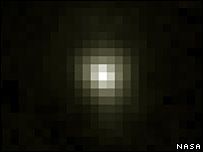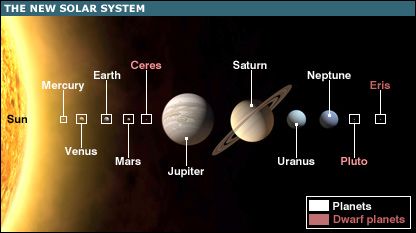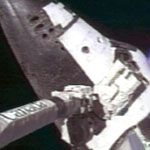jattpunjabi
Member
Astronomers name 'world of chaos'
 Eris gave rise to discord within the astronomical community
Eris gave rise to discord within the astronomical community
The distant world whose discovery prompted leading astronomers to demote Pluto from the rank of "planet" has now been given its own official name.
Having caused so much consternation in the International Astronomical Union (IAU), the object has been called Eris, after the Greek goddess of discord.
Eris is larger than Pluto, which put scientists in the fix of having to call them both planets - or neither.
Both bodies have now been put in the new classification of "dwarf planets".
Eris' discoverer, Michael Brown of the California Institute of Technology, told the Associated Press that the name was an obvious choice, calling it "too perfect to resist".
In mythology, Eris caused a quarrel among goddesses that sparked the Trojan War. In real life, Eris also caused strife, forcing scientists to produce a strict definition of the term planet - and that eventually led to Pluto losing the status it had held since its discovery in 1930.
The need for a strict definition was deemed necessary after new telescope technologies began to reveal far-off objects that rivalled Pluto in size.
 ERIS - WORLD OF DISCORD
ERIS - WORLD OF DISCORD

First seen in 2003 but finally recognised in 2005
Given the designation 2003 UB313 until formal naming
Highly elongated orbit around Sun lasting 560 years
Currently positioned some 14.5 billion km from Earth
Has extremely frigid surface temperature of -250C
May have thin atmosphere when closest to Sun
Is accompanied by a satellite now given the name Dysnomia
Without a new nomenclature, these discoveries raised the prospect that textbooks could soon be talking about 50 or more planets in the Solar System.
That prospect proved too much for IAU members who took the historic decision last month to redefine the Solar System.
Eris - initially given the codename "Xena" after a TV character - was discovered on 8 January, 2005, at the Palomar Observatory in California.
Its exact size is difficult to measure, being small and faint; Brown's team, using the Hubble telescope, found the object's diameter to be just 70km bigger than Pluto's. Another team, using a radio telescope in Spain, has measured Eris to be some 700km larger than Pluto.
Eris has a moon, and this too now has an official name: Dysnomia, the daughter of Eris known as the spirit of lawlessness.
The "new" Solar System agreed at the IAU's General Assembly has eight planets - Mercury to Neptune - and at least three dwarf planets: Pluto, Eris and the largest asteroid in the Solar System, Ceres.
Astronomers opposed to Pluto's demotion have launched a petition to try to get it reinstated.

http://newsvote.bbc.co.uk/mpapps/pagetools/email/news.bbc.co.uk/2/hi/science/nature/5344892.stmhttp://newsvote.bbc.co.uk/mpapps/pagetools/print/news.bbc.co.uk/2/hi/science/nature/5344892.stm
 SEE ALSO
SEE ALSO
Pluto vote 'hijacked' in revolt
25 Aug 06 | Science/Nature
Pluto loses status as a planet
24 Aug 06 | Science/Nature
Q&A: Pluto's planetary demotion
24 Aug 06 | Science/Nature
Crunch time for Planet Pluto
20 Jun 06 | Science/Nature
Pluto probe launches from Florida
20 Jan 06 | Science/Nature
Distant world tops Pluto for size
01 Feb 06 | Science/Nature
Mission guide: New Horizons
19 Jan 06 | Science/Nature
The girl who named a planet
13 Jan 06 | Science/Nature
Astronomers detect '10th planet'
30 Jul 05 | Science/Nature

internet sites


The distant world whose discovery prompted leading astronomers to demote Pluto from the rank of "planet" has now been given its own official name.
Having caused so much consternation in the International Astronomical Union (IAU), the object has been called Eris, after the Greek goddess of discord.
Eris is larger than Pluto, which put scientists in the fix of having to call them both planets - or neither.
Both bodies have now been put in the new classification of "dwarf planets".
Eris' discoverer, Michael Brown of the California Institute of Technology, told the Associated Press that the name was an obvious choice, calling it "too perfect to resist".
In mythology, Eris caused a quarrel among goddesses that sparked the Trojan War. In real life, Eris also caused strife, forcing scientists to produce a strict definition of the term planet - and that eventually led to Pluto losing the status it had held since its discovery in 1930.
The need for a strict definition was deemed necessary after new telescope technologies began to reveal far-off objects that rivalled Pluto in size.


First seen in 2003 but finally recognised in 2005
Given the designation 2003 UB313 until formal naming
Highly elongated orbit around Sun lasting 560 years
Currently positioned some 14.5 billion km from Earth
Has extremely frigid surface temperature of -250C
May have thin atmosphere when closest to Sun
Is accompanied by a satellite now given the name Dysnomia
Without a new nomenclature, these discoveries raised the prospect that textbooks could soon be talking about 50 or more planets in the Solar System.
That prospect proved too much for IAU members who took the historic decision last month to redefine the Solar System.
Eris - initially given the codename "Xena" after a TV character - was discovered on 8 January, 2005, at the Palomar Observatory in California.
Its exact size is difficult to measure, being small and faint; Brown's team, using the Hubble telescope, found the object's diameter to be just 70km bigger than Pluto's. Another team, using a radio telescope in Spain, has measured Eris to be some 700km larger than Pluto.
Eris has a moon, and this too now has an official name: Dysnomia, the daughter of Eris known as the spirit of lawlessness.
The "new" Solar System agreed at the IAU's General Assembly has eight planets - Mercury to Neptune - and at least three dwarf planets: Pluto, Eris and the largest asteroid in the Solar System, Ceres.
Astronomers opposed to Pluto's demotion have launched a petition to try to get it reinstated.

http://newsvote.bbc.co.uk/mpapps/pagetools/email/news.bbc.co.uk/2/hi/science/nature/5344892.stmhttp://newsvote.bbc.co.uk/mpapps/pagetools/print/news.bbc.co.uk/2/hi/science/nature/5344892.stm

Pluto vote 'hijacked' in revolt
25 Aug 06 | Science/Nature
Pluto loses status as a planet
24 Aug 06 | Science/Nature
Q&A: Pluto's planetary demotion
24 Aug 06 | Science/Nature
Crunch time for Planet Pluto
20 Jun 06 | Science/Nature
Pluto probe launches from Florida
20 Jan 06 | Science/Nature
Distant world tops Pluto for size
01 Feb 06 | Science/Nature
Mission guide: New Horizons
19 Jan 06 | Science/Nature
The girl who named a planet
13 Jan 06 | Science/Nature
Astronomers detect '10th planet'
30 Jul 05 | Science/Nature

internet sites


